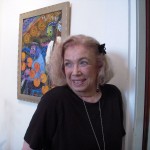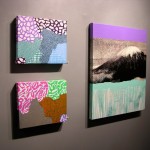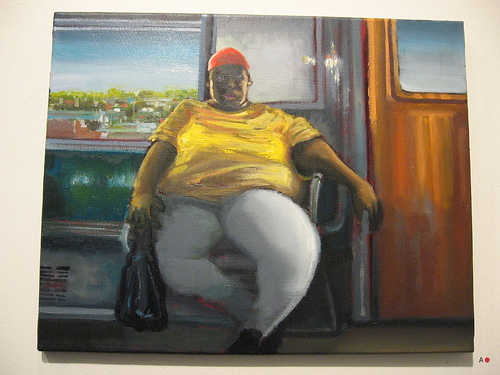
R. L. Washington’s Riding the L, 16 x 20 inches
It’s easy to dismiss R.L. Washington’s paintings, mostly narrative and genre paintings from a painter with a seemingly sentimental eye, as nothing more. That would be a mistake. Although the work is clearly in the social realist tradition of Dox Thrash and New Deal artists, Washington walks a tightrope between the expected and the unexpected in his show, Slices of Life, at Sande Webster Gallery.
Unexpected flashes of color and fluid dashes of paint, careful observation of African American life, and feelings of ambivalence make these paintings interesting. I have to think that there’s an audience for both the expected and unexpected, judging by which paintings sold.
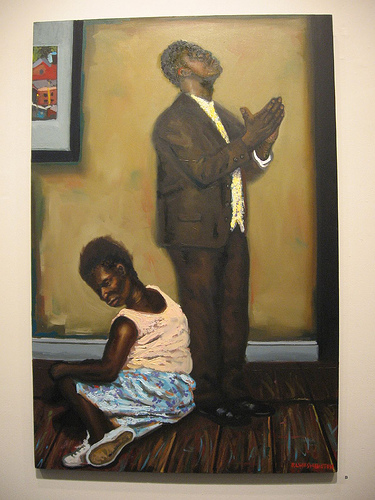
Keep on Praying, 36 x 24 inches
Riding the L is a portrait of a heavy-set subway rider depicted with a breathtaking honesty mixed with fluid painting. The particularity and focus on character in Riding the L is not present in Keep on Praying, a narrative painting that is not necessarily either benign or holy, although I suppose someone might read it that way. I take the title as ironic. And I’m not so sure that Thy Will Be Done doesn’t have a dose of irony as well. Without that ambivalence, Washington’s religious subjects would teeter into Norman Rockwellian sentimentality.
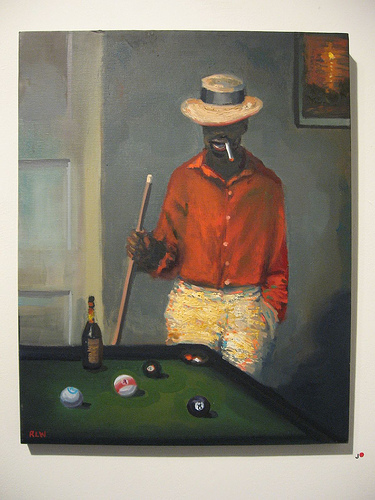
Pool Player, by R.L. Washington, 20 x 16 inches
Washington has a number of paintings in which impasto turns pieces of clothing into creatures that practically walk right out of the painting, most notably in Slick and Pool Player (in Pool Player, I also admired a dash of paint that depicts a wonderfully slick, slack lower lip). The impastoed clothes suggest the wearer’s vanity and also suggest clothes as symbols of materialism. And that eye for the things of this world is the surprise in the otherwise straightforward Sweet Hour of Prayer. The mushroom cloud of hair is all vanity.
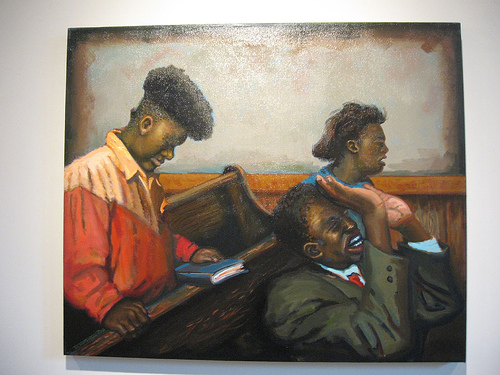
R.L. Washington, Sweet Hour of Prayer, 32″ x 38″
Many of the paintings have less of an edge, but a good number of them win me over with color–the cadmium orange edge on a blue and white pickup truck, the clothing details of the motley crew riding a subway in Underground Together (oh this one has the Contemporary edge of sharply observed details), the green and yellow of an overpass in Short Cut Home.
This is Washington’s second solo show at Sande Webster. He has a 1979 BFA from Philadelphia College of Art (now University of the Arts) and also attended the University of Pennsylvania, and he’s been plying the National Black Fine Arts shows and was a member of CAN (now CFEVA). He had a number of red dots.
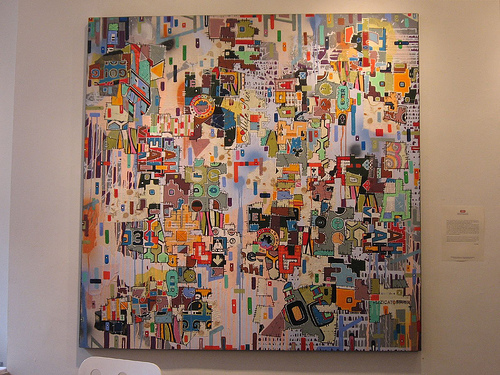
TRT-1000, by Eric Mack, 68 x 68 inches
Also at Sande Webster, Eric Mack’s show Celestial Sheet Music offers 11 mixed media visions of cities. The map-like works have become a little less outsidery, a little less abstract. Mack, an Atlanta artist, on this outing has a number of paintings with New York and Brooklyn as subjects. The large New York painting, TRT-1000, is quite similar to past work I’ve see by Mack, with an overall jazz-inspired grid that refuses to calm down, line up and behave. Two paintings relating to Brooklyn, BBR-0030 and VBV-1919 have more of a focus and sense of space, of the sky above and the ground below. The calmer edges in these two however are not necessarily about peace. VBV in particular strikes me as a vision of the World Trade Center towers in collapse. Little explosions dot the sky, and some drips at the top remind me of the buildings’ scaffolding that stayed vertical while all else was lost. Like all of Mack’s work, there’s a sense of signage, graffiti, everything around us in the city.
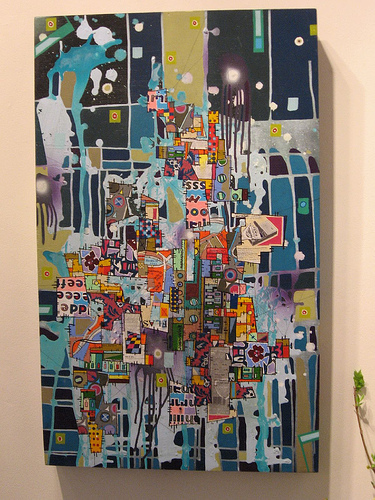
BBR-0030, by Eric Mack. 36 x 22 inches. My son lives somewhere on this map. I saw the intersection when I looked up close.
Mack’s rough grids made me think of Mark Bradford and Mondrian. Not so the Brooklyn paintings, in which the musical inspiration is more evident and the color has become more important than the texture. In all of Mack’s work, words create the aura of maps, and give a sense of particular place.
I really like this guy’s work.


